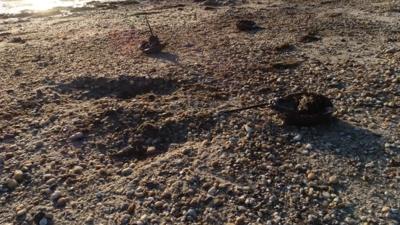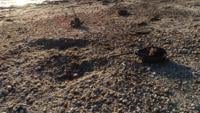SLAUGHTER BEACH, Del. - Something found on Delaware beaches is helping in the race to a COVID-19 vaccine. Horseshoe crab blood is used in four labs along the east coast. Testing for potential COVID-19 vaccines puts the living fossil at the forefront of modern medicine.
25 to 30 million horseshoe crabs live in the Delaware Bay alone, making up their largest population in the world. Some of them are collected for their blue blood, which is used to test vaccines for endotoxins, something that can be harmful, or even deadly to people. Potential COVID-19 vaccines are already being tested in horseshoe crab labs.
Atlantic States Marine Fisheries CommissionHorseshoe Crab Advisory Panel Chairman Allen Burgenson says, "The horseshoe crab only has one type of blood cell called an amebocyte and those amebocytes contain granules. When a bacteria invades their tissues, that clots." That reaction is used to test for endotoxins in pharmaceutical products before they're given to people, like potential COVID-19 vaccines. Burgenson says about 3 tbs. of blood are drawn from many crabs and LAL is created out of that pool. The pharmaceutical industry uses LAL to test their drug products before they are distributed to the public and before they are given to subjects in clinical trials. "We call that test the limulus amebocyte lysate (LAL)," Burgenson says. The process has been used for more than 40 years, which is about how long Burgenson has been in the industry. "For all the clinical trials, whether it be Phase 1, Phase 2 or Phase 3, all of those lots were tested for the presence of endotoxins, using LAL," Burgenson says.
Conserve Wildlife Foundation of New JerseyExecutive Director David Wheeler worries what this will do to the horseshoe crab population, which has been declining for decades. "Horseshoe crabs have been swimming the earth for over 400 million years," Wheeler says. "We celebrate the fact that horseshoe crabs can serve this role, but at the same time we encourage the role of synthetic lysate." Wheeler says the labs are supposed to return the horseshoe crabs to the water within 36 hours after taking their blood, but he worries that the race for a COVID-19 vaccine could potentially put them in higher demand. "We would not only have these tremendous impacts to our medicine and public health potentially, but also to the ecosystem, all the shorebirds, the fish, the reptiles like Diamondback terrapins that depend on horseshoe crab eggs." Burgenson says the lives saved outweigh what he says is a small burden on the crabs and the labs. He says weak crabs are not taken and that the labs ensure the ones that do give up blood are moving and swimming when they are returned to the water. He says the crabs are usually returned to the water within 12 hours, but always under 24 hours. "The United States Pharmacopeia has estimated that the world will need approximately 5 billion doses," says Burgenson. "The average batch size is approximately 100,000 vials. That would be 50,000 batches or lots of COVID-19 vaccine." Burgenson says that would take less than a day's production of LAL to test. He says based on his experience with other vaccines it's likely that a COVID-19 vaccine will not be distributed until 2021.







